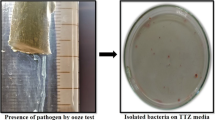Abstract
Two non-conventional chemicals, ZnSO4 (10−4 mM) and oxalic acid (4 mM) were tested (alone as well as in combination with seeds bacterized with Pseudomonas syringae strain PUR46 and vermicompost substitution in the potting soil), for their ability to suppress collar rot of chickpea (Cicer arietinum) caused by Sclerotium rolfsii under greenhouse conditions. ZnSO4 and oxalic acid were applied as pre-inoculation foliar spray on chickpea and subsequently challenged with S. rolfsii. Both the chemicals provided significant protection to chickpea compared to control (100% plant mortality) when used alone as well as in combination with PUR46 and vermicompost. However, ZnSO4 was more effective than oxalic acid against S. rolfsii. Amongst the treatments tried, plant mortality was least when ZnSO4 was used in combination with seed bacterization with PUR46 and 25% vermicompost substitution. The findings indicate the utility of integration of the above factors in managing collar rot efficiently.
Similar content being viewed by others
References
Anahosur KH (1999) Management of plant diseases through antagonists an overview. In: National seminar on recent advances in plant pathology held at Department of Botany, Pune on 30–31 March, 1999, p 38
Bhatacharya A, Roy AK (1998) Induction of resistance in rice plant against sheath blight with non conventional chemicals. Indian Phytopathol 51:81–86
Bolle-Jones EW, Hilton RN (1956) Zinc-deficiency of Hevea brasiliensis as a predisposing factor to Oidium infection. Nature (London) 177:619–620
Cakmak IM (2000) Possible roles of zinc in protecting plant cells from damage by reactive oxygen species. New Phytol 146:185–205
Cessna SG, Sears VE, Dickman MB, et al (2000) Oxalic acid, a pathogenicity factor for Sclerotinia sclerotiorum, suppresses the oxidative burst of the host plant. Plant Cell 12:2191–2199
Graham DR, Webb MJ (1991) Micronutrients and disease resistance and tolerance in plants. In: Mortvedt JJ, Cox FR, Shuman LM, Welch RM (eds) Micronutrients in agriculture, 2nd ed. Soil Science Society of America, Inc., Madisoa, WI, USA, pp 329–370
Higgins BE (1927) Physiology and parasitism of Sclerotium rolfsii. Phytopathology 17:417–448
Huber DM, Watson RD (1970) Effect of organic amendments on soil-borne plant pathogens. Phytopathology 60:22
Krauss A (1999) Balanced nutrition and biotic stress. In: IFA Agricultural Conference on Managing Plant Nutrition, 29 June 1999–2 July 1999, Barcelona, Spain
Lazorovits L (1988) Induced resistance-xenobiotics. In: Singh R, Singh U, Hees W, Weber D (eds) Experimental and conceptual plant pathology. Oxford and IBH Publishing Company Pvt. Ltd., New Delhi, pp 575–592
Mandal NC, Sinha AK (1992) An alternative approach for the control of Fusarium wilts of tomato. Indian Phytopathol 45:194–198
Marschner H (1995) Mineral nutrition of higher plants, 2nd ed. Academic Press, London, p 889
Maxwell DP, Bateman DF (1968) Influence of carbon source and pH on oxalate accumulation in culture filtrates of Sclerotium rolfsii. Phytopathology 58:1351–1358
Mengel K, Kirkby EA (2001) Principles of plant nutrition, 5th ed. Kluwer, Amsterdam, Netherlands, p 847
Pandey N, Pathak GC, Singh AK, Sharma CP (2002) Enzymatic changes in response to zinc nutrition. J Plant Physiol 159:1151–1153
Punja ZK (1985) Biology, ecology and control of Sclerotium rolfsii. Annu Rev Phytopathol 23:97–127
Punja ZK, Jenkins SF (1984) Light and scanning electron microscopic observations of calcium oxalate crystals produced during growth of Sclerotium rolfsii in culture and in infected tissues. Can J Bot 62:2028–2032
Sarkar ML, Sinha AK (1992) Control of sheath blight of rice with non-conventional chemicals. Indian Phytopathol 44:379–381
Sarma BK, Basha SA, Singh DP, Singh UP (2007) Use of non-conventional chemicals as an alternative approach to protect chickpea (Cicer arietinum) from Sclerotinia sclerotiorum stem rot. Crop Prot 26:1042–1048
Sarma BK, Singh DP, Mehta S, Singh HB, Singh UP (2002) Plant growth-promoting rhizobacteria-elicited alterations in phenolic profile of chickpea (Cicer arietinum) infected by Sclerotium rolfsii. J Phytopathol 150:277–282
Singh UP, Sarma BK, Singh DP (2003) Effect of plant growth-promoting rhizobacteria and culture filtrate of Sclerotium rolfsii on phenolic and salicylic acid contents in chickpea (Cicer arietinum L.). Curr Microbiol 46:131–140
Singh UP, Sarma BK, Singh DP, Bahadur A (2002) Studies on exudates- depleted sclerotial development and effect of oxalic acid, sclerotial exudates and culture filtrate of Sclerotium rolfsii in induction of phenolic acids in Chickpea (Cicer arietinum). Can J Microbiol 48:443–448
Sinha AK (1984) A new concept in plant disease control. Sci Cult 50:181–186
Sinha AK (1995) Possible role of phytoalexins inducer chemicals in plant disease control. In: Danial M, Purkayastha RP (eds) Handbook of Phytoalexin metabolism and action. Marcel Dekker, New York, pp 555–591
Steel RGD, Torrie JH (1980) Principles and procedures of statistics: a biometric approach. Mcgraw-Hill, New York
Toal ES, Jones PW (1999) Induction of systemic resistance to Sclerotinia sclerotiorum by oxalic acid in oilseed rape. Plant Pathol 48:759–767
Weller DM, Cook RJ (1983) Suppression of take-all of wheat by seed bacterization with fluorescent pseudomonad. Phytopathology 73:463–469
Whipps JW (2001) Microbial interactions and biocontrol in rhizosphere. J Exp Bot 52:487–511
Zhang YN, Liu YH (1992) Studies on cucurbits disease control by non-fungicidal compounds. Acta Phytopathol Sinica 22:241–244
Author information
Authors and Affiliations
Corresponding author
Rights and permissions
About this article
Cite this article
Sahni, S., Sarma, B.K. & Singh, K.P. Management of Sclerotium rolfsii with integration of non-conventional chemicals, vermicompost and Pseudomonas syringae . World J Microbiol Biotechnol 24, 517–522 (2008). https://doi.org/10.1007/s11274-007-9502-8
Received:
Accepted:
Published:
Issue Date:
DOI: https://doi.org/10.1007/s11274-007-9502-8




